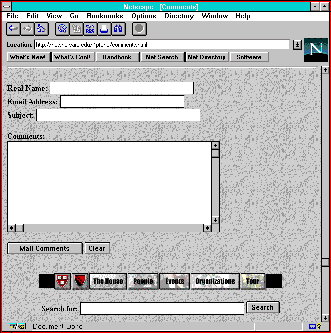
Figure 2.1. A sample form. (08)
|
eekim.com >
Publications >
CGI Developer's Guide >
Chapter 2
|
Publications | Software | Talks | Weblog | About |
<Next | Table of Contents | Previous> (02)
A few years ago, I was setting up World Wide Web pages for Harvard college, and I wanted to include a page where people could submit their comments about the pages. At the time, the Web was young and the documentation scarce. I, like many others, depended on the terse documentation and other people's code to learn how to program CGI. Although this method of learning required some searching, plenty of experimentation, and a lot of questions, it was very effective. This chapter is a mirror of my early struggles with CGI (with several refinements, of course!). (04)
Although gaining a complete understanding and mastery of the Common Gateway Interface takes some time, the protocol itself is fairly simple. Anyone with some basic programming skills and familiarity with the Web is capable of quickly learning how to program fairly sophisticated CGI applications in the same way I and others learned a few years ago. (05)
The objective of this chapter is to present the basics of CGI in a comprehensive and concise manner. Every concept discussed here is covered in greater detail in later chapters. However, upon finishing this chapter, you should be immediately capable of programming CGI applications. Once you reach that point, you have the option of learning the remaining subtle nuances of CGI either by reading the rest of this book or by simply experimenting on your own. (06)

Figure 2.1. A sample form. (08)
You can reduce CGI programming to two tasks: getting information from the Web browser and sending information back to the browser. This is fairly intuitive once you realize how CGI applications are usually used. Often, the user is presented with a form to complete, such as the one in Figure 2.1. Once the user fills out this form and submits it, the information is sent to a CGI program. The CGI program must then convert that information into something it understands, process it appropriately, and then send something back to the browser, whether it is a simple acknowledgment or the results of a complex database search. (07)
In other words, programming CGI requires understanding how to get input from and how to send output back to the Web browser. What goes on between the input and output stages of a CGI program depends on what the developer wants to accomplish. You'll find that the main complexity of CGI programming lies in that in-between stage; after you figure out how to deal with the input and output, you have essentially accomplished what you need to know to become a CGI developer. (09)
In this chapter, you learn the basic concepts behind CGI input and output as well as other rudimentary skills you need to write and use CGI, including how to create HTML forms and how to call your CGI programs. The chapter covers the following topics: (010)
Because of the nature of this chapter, I only casually discuss certain topics. Don't worry; all of these topics are explored in much more detail in the other chapters. (017)
<Next | Table of Contents | Previous> (018)
Copyright © 1997 Sams.Net Publishing (019)
|
Copyright © 2001-2003 Eugene Eric Kim /
eekim@eekim.com.
All rights reserved. Revision: $Id: 0201.html,v 1.1 2001/05/22 18:53:48 eekim Exp $ |
Publications | Software | Talks | Weblog | About |